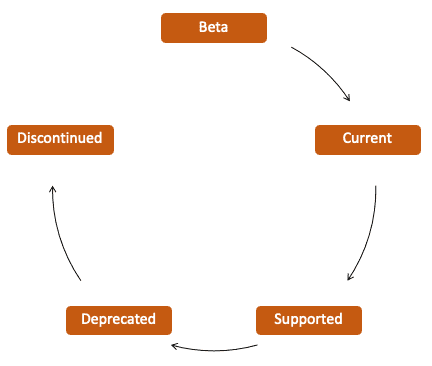Wowza Video REST API lifecycle management
The Wowza Video service naturally evolves over time as we improve the streaming experience. As part of this evolution, we add new features as well as remove functionality that becomes outdated. Our goal is to provide a well-maintained REST API that delivers reliably. To do this, we actively manage the lifecycle of the Wowza Video REST API.
API lifecycle
Our API lifecycle begins at the Beta stage, and 4 versions of our REST API are available at any given time. To ensure a stable API and minimize disruption to your streaming solutions, we add new features and remove outdated functionality in the Beta version of the API.
Every 6 months, we test and finalize the Beta version and then move all existing API versions along to the next lifecycle stage. Beta moves to Current, Current to Supported, and so on. When an API reaches Discontinued, it is removed from production and no longer available.

We recommend that you migrate to the new Current version of the REST API as it becomes available. This ensures you're using the most up-to-date, stable version of the API. As a version cycles through the stages, it becomes increasingly outdated and when it reaches Deprecated, it may no longer function as expected.
While we strive to maintain backwards compatibility between versions of the API to simplify your migration, it's not always possible when we add significant new functionality or improve architectural features. Staying current with the REST API is an easier migration task than migrating from an API version several stages removed from the current version with more cumulative changes.
Info
Use automation to alert you when you are no longer using the current version of the REST API. To learn more, see Manage API versions in your code.
Learn more about each stage of our API lifecycle:
- Beta — The beta version contains everything that's in the current version as well as some features and functionality that are still in development. These work-in-progress features aren't fully tested and are subject to change. When we're done testing, we'll promote the beta version to the current version and then create a new beta with new features. You're free to use the beta version for testing and evaluation, but beta versions aren't intended for use in production environments and we caution against using a beta in production. There is only one beta version available at any time.
- Current — The current version offers the most complete, up-to-date, tested, and stable code base. We strongly recommend using the current version in your production environment. There is only one current version available at any time.
-
Supported
— The
supported version was current at one time but has been replaced by a
newer version of the API. This version doesn't have the newest
features, and may contain features or functions that are outdated
and don't offer the most efficient methods for accomplishing your
streaming goals. If you're using this version, we recommend that you
upgrade to the current version, as soon as possible.
Note: Historically, the Wowza Video REST API has had designations for Supported 1 and Supported 2 versions. Beginning in October 2023, we'll begin the process of moving to only a single supported version. Once the existing API versions complete their lifecycle, we'll no longer maintain more than one supported version.
- Deprecated — A deprecated version isn't guaranteed to work in production environments. Also, all relevant documentation is no longer accessible. If you're using a deprecated version, update to the current version immediately.
- Discontinued — A discontinued version is no longer accessible. This stage was formerly known as Sunset .
Lifecycle schedule
As we bring our development processes into alignment with our lifecycle management process, this table reflects actual delivery dates, anticipated delivery dates, and scheduled delivery dates.
- Actual delivery dates are in plain text. These are the dates we delivered in our previous API lifecycle management process.
- Anticipated delivery dates are bold . These are the dates that we plan on moving the API to the next stage.
* Dates are in MM/DD/YYYY format.
| API Version | Beta | Current | Supported 1 | Supported 2 * | Deprecated | Discontinued |
|---|---|---|---|---|---|---|
| 1.9 | 4/19/2022 | 9/29/2022 | 3/15/2023 | 10/03/2023 | 3/20/2024 | 9/18/2024 |
| 1.10 | 9/29/2022 | 3/15/2023 | 10/03/2023 | 3/20/2024 | 9/18/2024 | 3/12/2025 |
| 1.11 | 3/15/2023 | 10/03/2023 | 3/20/2024 | 9/18/2024 | 3/12/2025 | 9/17/2025 |
| 1.12 | 10/03/2023 | N/A | N/A | N/A | N/A | N/A |
| 2.0 | N/A | 2/8/2024 | 9/18/2024 | 3/12/2025 | 9/17/2025 | 3/18/2026 |
* Historically, the Wowza Video REST API has had designations for Supported 1 and Supported 2 versions. Beginning in October 2023, we'll begin the process of moving to only a single supported version. Once the existing API versions complete their lifecycle, we'll no longer maintain more than one supported version.
Manage API versions in your code
We recommend that you use the current version of the API, always. Use the Query for version status endpoint to automate notification when there's a new current version of the REST API available, then plan and execute your migration to the new current version.
curl -X GET \
-H "Authorization: Bearer ${WV_JWT}" \
'https://api.video.wowza.com/api/versions'The sample response looks similar to this, but differs according to current version status. Because current and supported APIs are the only ones intended for production use, those are the only statuses returned in the response.
{
"1.11": {
"status": "current",
"base_uri": "/api/v1.11"
},
"1.10": {
"status": "supported",
"base_uri": "/api/v1.10"
}
...
}Consult the Wowza Video REST API migration guide for information about changes between API version as you plan your migration to a new current version of the API.